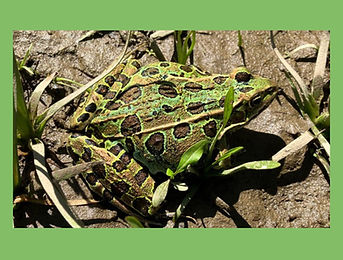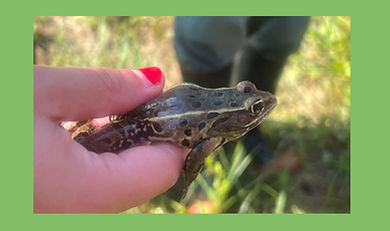Northern Leopard Frog
Lithobates pipiens
Conservation Status:
State Status: Imperiled (NatureServe, 2024)
State Listing: Special Concern (DEEP, 2015)
Global Assessment: Least Concern (IUCN, 2021)
Listen to call:
(Hubble BB, 2017)
Description
Northern leopard frogs grow up to four inches long (Watkins-Colwell, 2024). They range from tan to green in color with dark spots on their back. This species has a white stomach and lighter dorsolateral ridges (the ridges that run from behind each eye down the back).
Habitat
Northern leopard frogs can be found in bodies of water with lots of aquatic vegetation. They commonly live in floodplains and grasslands.
Behavior
These frogs eat a variety of invertebrates, such as insects and worms. Predators include snakes and small mammals. When threatened, they rely on their speed to get away, often escaping in a zig-zag pattern (Quinn, 2020).
Breeding season occurs in the late spring in vernal pools. Males will gather in the water and call out to attract females. Eggs are laid in clumps.
Range


Northern Leopard Frog
Photographed by Eric M. Powell
Often Confused with

Atlantic Coast Leopard Frog
Photographed by John Michael Arnett
These two types of leopard frogs are very visually similar and were only recently described as two distinct species. Atlantic coast leopard frogs are duller in color, ranging from browns to muted greens. Northern leopard frogs are a brighter green and have larger spots. These two differences can be seen in the images above.

Northern Leopard Frog
Photographed by Eric M. Powell
Often Confused with

Pickerel Frog
Photographed by Stephanie Campbel
The main difference between these two species is that the spots found on leopard frogs are round and appear randomly across their skin, whereas pickerel frogs have larger rectangular spots that come in two rows. Pickerel frogs have snouts that are more blunt, and a bright yellow coloring on the underside of their hind legs. They are typically a brown color while leopard frogs are green. The difference in coloration and spot pattern can clearly be seen in the images above.
References
Department of Energy and Environmental Protection. (2015, August 5). Endangered, Threatened, and Special Concern Amphibians. Connecticut. https://portal.ct.gov/deep/endangered-species/endangered-species-listings/endangered-threatened--special-concern-amphibians.
Hubble BB. (2017, March 8). Northern Leopard Frog Calling. Youtube. https://www.youtube.com/watch?v=4YTMGp46Rq8.
iNaturalist. (2024). Observations. California Academy of the Sciences / National Geographic Society. https://www.inaturalist.org/observations?place_id=49&taxon_id=66003.
International Union for Conservation Of Nature and Natural Resources. (2021, August 3). Northern Leopard Frog. https://www.iucnredlist.org/species/79079800/3072377.
Klemens, M. W. et al. (2021). Conservation of Amphibians and Reptiles in Connecticut. Department of Energy and Environmental Protection. https://ctdeepstore.com/products/conservation-of-amphibians-reptiles-in-connecticut.
NatureServe. (2024, November 1). Lithobates pipiens. https://explorer.natureserve.org/Taxon/ELEMENT_GLOBAL.2.101454/Lithobates_pipiens.
Quinn, D. P. (2020). Northern Leopard Frog. Connecticut Herpetology. https://www.ctherpetology.com/northern-leopard-frog.
Watkins-Colwell, G. J. (2024). Northern Leopard Frog - Rana pipiens. Yale Peabody Museum. https://peabody.yale.edu/explore/collections/herpetology/guide-amphibians-reptiles-connecticut.
Watkins-Colwell, G. J. et al. (2006). New Distribution Records for Amphibians and Reptiles in Connecticut, with Notes on the Status of an Introduced Species. Sacred Heart University. https://digitalcommons.sacredheart.edu/cgi/viewcontent.cgi?article=1058&context=bio_fac.
Page updated November 19, 2024
